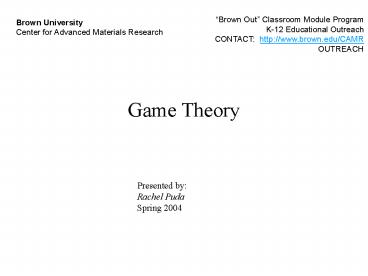Brown Out Classroom Module Program PowerPoint PPT Presentation
1 / 7
Title: Brown Out Classroom Module Program
1
Brown Out Classroom Module Program K-12
Educational Outreach CONTACT http//www.brown.ed
u/CAMR OUTREACH
Brown University Center for Advanced Materials
Research
Game Theory
Presented by Rachel Puda Spring 2004
2
Game Theory
Next Page
3
Game 1 Matching Coins
(Simultaneous Move Game)
Player 1 wins if coins match Player 2 wins if
coins do not match
Player 1 and Player 2 choose heads or tails
simultaneously.
Normal Form of game
Normal Form Matrix representation of a
simultaneous move game
Next Page
4
Nash Equilibrium named after John Nash, is a set
of strategies, one for each player, such that no
player has incentive to change her action
Pure Strategy a move chosen by a nonrandom
course of action
In the simultaneous move matching coins game
there is no pure strategy Nash Equilibrium
because one player will always want to change his
play.
Example Player 1 chooses Heads Player
2 chooses Heads Player 1 wins because both coins
match. This is not a Nash Equilibrium because
Player 2 has incentive to change his move to
Tails so that he would win.
Next Page
5
Mixed Strategy a move which is chosen from a set
of strategies with specific probabilities
In order to use a mixed strategy the players must
be indifferent to either option, heads or tails.
By multiplying Player 1s payoffs by P and 1-P
and setting them equal to each other we can find
the percent of the time Player 1 should choose
each option.
We can see that both Player 1 and Player 2 should
play heads and tails in half of the games they
play.
Next Page
6
Game 2 Matching Coins
(Sequential Move Game)
Player 1 and Player 2 choose heads or tails one
after the other
Player 2 will always win because he can choose
his move based on Player 1s move.
Game Tree for Matching Coins
Game Tree a diagram used to represent sequential
move games
Next Page
7
Game 3 Rock Paper Scissors
The Rock Paper Scissors game is very much like
the matching coin game except with the exception
of an extra option.
Knowing this, we can see without the complex math
that to be indifferent to all 3 options both
players should play Rock, Paper and Scissors in
1/3 of their games.
Normal form of Rock Paper Scissors
To learn more about Game Theory visit
gametheory.net

